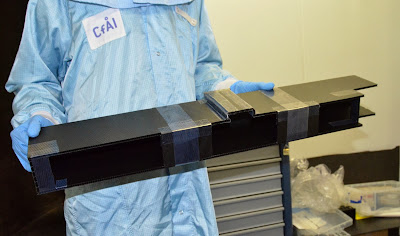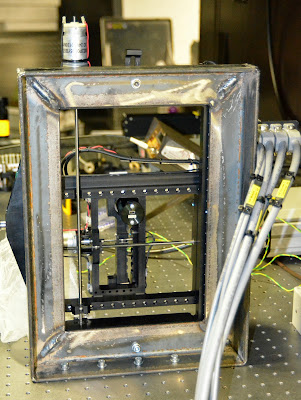Here's a peek inside the SALT aluminsing chamber while the guys were preparing to coat two more segments today. One bare segment's visible to the right of the
frame that holds all the little aluminium coils (which get blasted to
produce the coating), the other mirror's just out of sight on the
left-hand side.
Next door in the spectrometer room, David tackled the fore-optics straylight issue...
Building up a quite awesome baffle out of black correx.
The baffle encases the fore-optics while resting on top of the bridge that supports all the lenses.
Installing the baffle improved the situation, but some additional shielding was needed at the ends. Unfortunately all of this is temporary as correx is not vacuum-compatible, but at least we now know exactly what's required.
The necessary parts will be manufactured out of appropriate materials & installed at a later stage. In the meantime we'll just have to live with some scattered light in the red channel. Here's Baffle Man sporting that satisfied look of a superhero that's just saved the world :)
The next job in the queue was for Jürgen to measure the throughput of the HS fibres by shining the blue LED into the telescope end of the HS fibres & measuring the output at the start of the double-scrambler. This was done by holding the calibrated photodiode at the face of the fibre for the reading & pointing it away from the fibre to obtain a background measurement. While this might seem a bit rough, the results for both fibres were in remarkably good agreement with predictions based on the fibre manufacturer's transmission curves.
Then it was time for a full set of calibration frames, with both the ThAr lamp for arcs & a continuum source for flat fields, for all 4 modes, & for both cameras... Ugh - what a schlep! Only Then could Janus get going on setting up the FIF for the peaking up of its offset positions.
The fibres will be attached to the FIF tomorrow & their offset positions carefully mapped to ensure that light will be optimally directed into the fibres once we go on-sky.
We'll need to use the exposure meter for this procedure so that also had to be connected & tested. Below is what one sees when looking into the back of the housing for the photomultiplier tube - the distorted image produced by the exposure meter mirror that's attached to the grating. This was one of the sliced modes so you can see the 3 sections in the image.
This is the delicate photomultiplier tube, connected up to the tank. We've left this step to the end as the exposure meter's extremely vulnerable, both because it pokes awkwardly out the side of the tank & particularly because it's hugely sensitive & could be killed if exposed to too much light while powered up. We'll just have to be extra careful with it, & get Eddy to change its default state from On to Off.
We popped up to the telescope this evening to check how Eddy had gotten on - he's been doing the remote login thing to work on the software while still away on holiday. Hence we got to try out a couple of things, including initialisation, configuration & running a couple of procedures, as well as powering up the exposure meter. Things are looking good - thanks Eddy! I really should've brought my camera up with me - as Jürgen (who stayed down in the hostel with it) was quick to point out ;) D'oh!












No comments:
Post a Comment